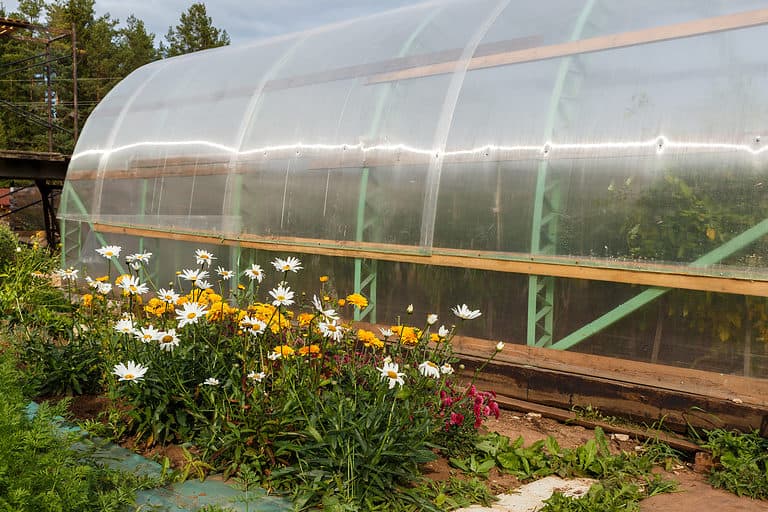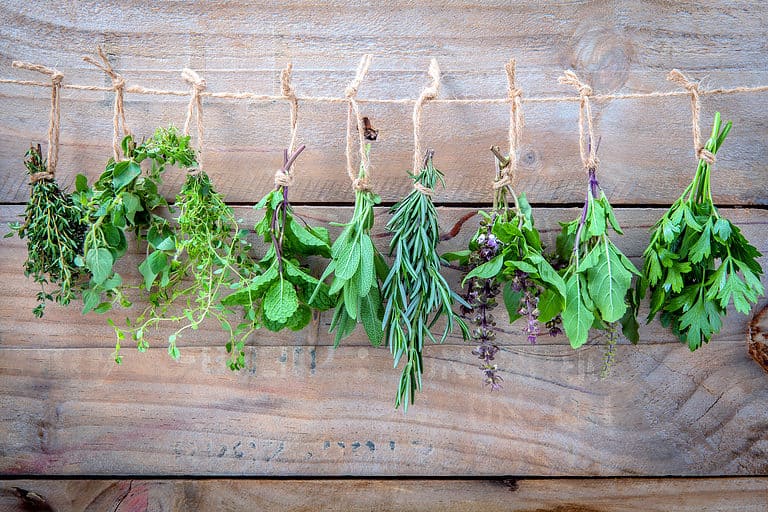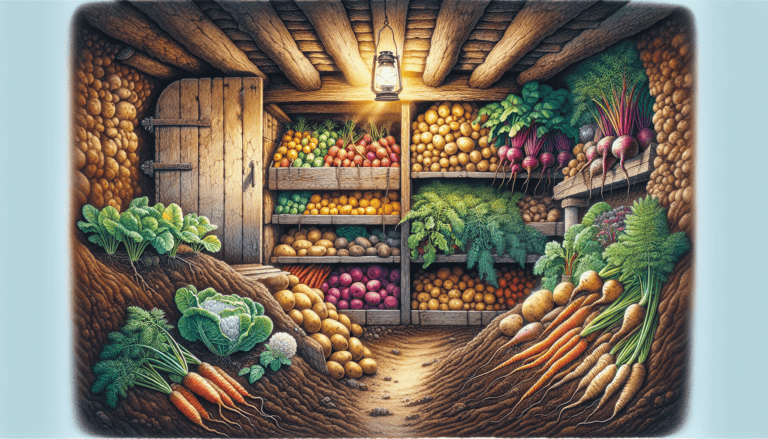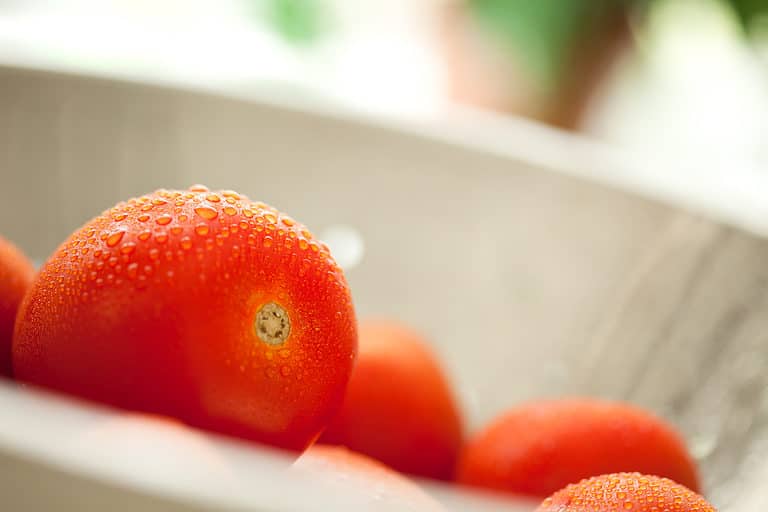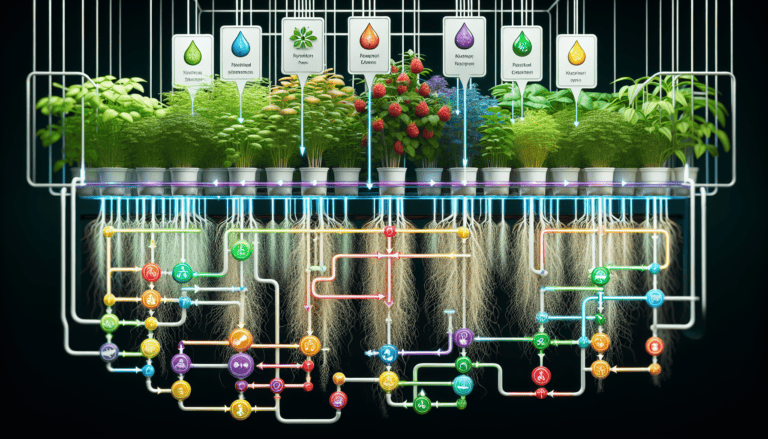Thriving Hydroponic Plants: Growing a Bountiful Harvest
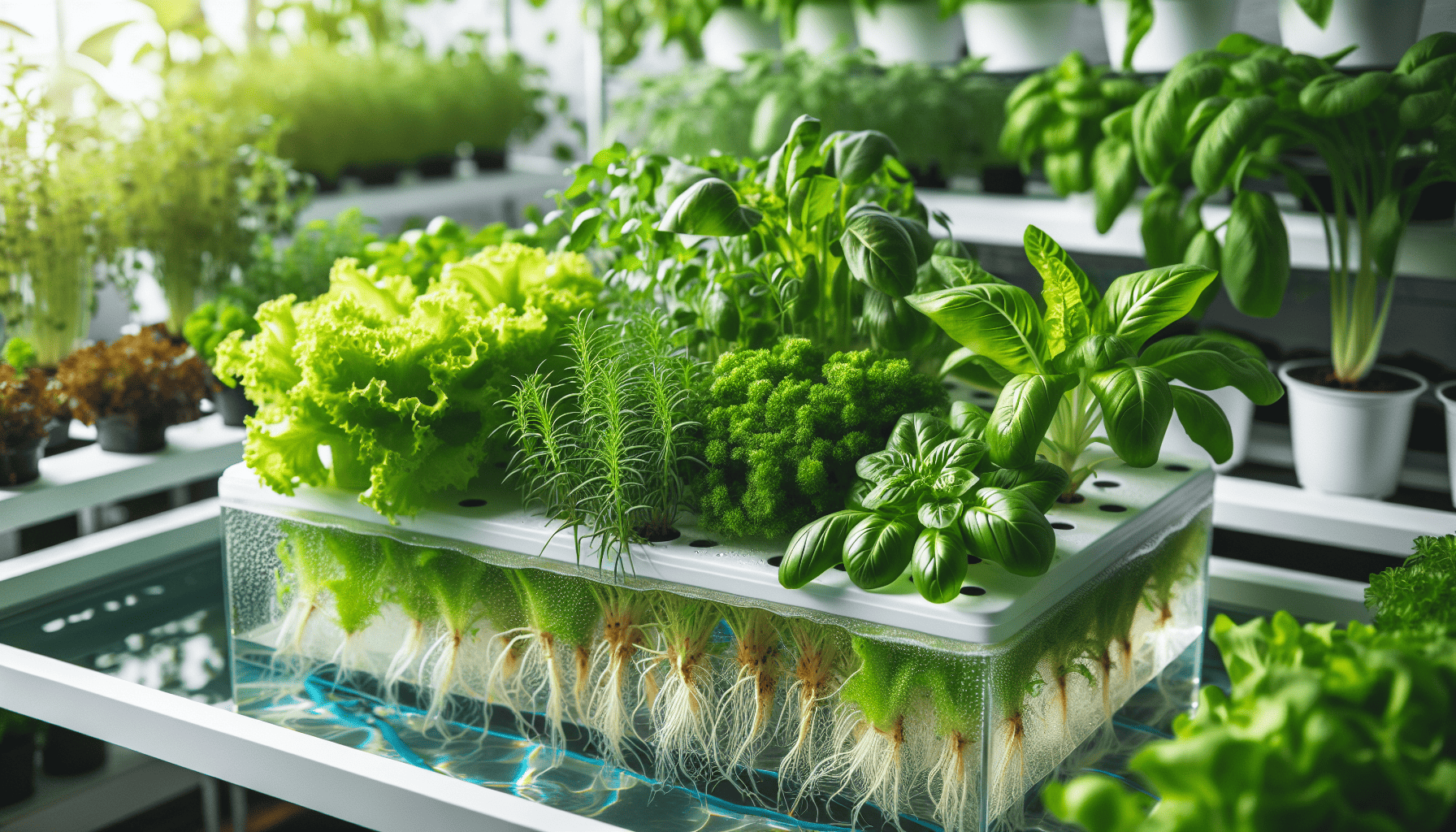
You may wonder if it’s possible to grow plants without the mess and limitations of soil. Hydroponic plants bypass traditional growing methods, instead thriving in a nutrient-rich water solution. By doing so, they leverage increased growth rates and reduced water consumption. This article provides a practical walkthrough for beginners interested in the what, why, and how of setting up a hydroponic garden.
Key Takeaways
Hydroponic gardening is a resource-efficient method of soilless cultivation suitable for many plants, with systems like the wick, ebb and flow, and deep water culture offering unique benefits for growing plants in nutrient-rich solutions.
Selecting the right plants, nutrients, and system setup is essential for a successful hydroponic garden, as different plants have varying light, nutrition, and support needs that must be tailored to the hydroponic environment.
Maintaining a healthy hydroponic environment involves regular maintenance such as monitoring pH levels, changing water, and managing pests and pathogens to promote rapid and sustained plant growth.
Exploring Hydroponic Gardening: The Basics

Hydroponic gardening is a type of soilless cultivation that can be done both indoors and outdoors. This form of horticulture offers an exciting opportunity for gardeners, regardless of their level of experience. What sets hydroponics apart from other forms? It’s known for its efficient use of resources – growing spinach in a hydroponic system requires much less water than traditional in-ground methods thanks to nutrient-rich water solutions.
In this method, plants get their nutrients from specialized fertilizers designed specifically for hydroponics. These contain high levels of nitrogen, phosphorus, and potassium, which are essential elements for plant growth. The optimal pH range for thriving plants in a hydroponic system is between 5.4 to 7.0, but it can easily be adjusted using commercially available products or substances like sulfuric acid, phosphoric acid or citric acid if needed. Additionally, the choice of suitable plants plays a crucial role. Each species has different light and temperature requirements, so careful selection is necessary to ensure success with your own personal indoor garden.Among the most popular choices are lettuce, tomatoes, basil, cucumbers, and strawberries.
Unveiling the Secrets of Hydroponic Systems
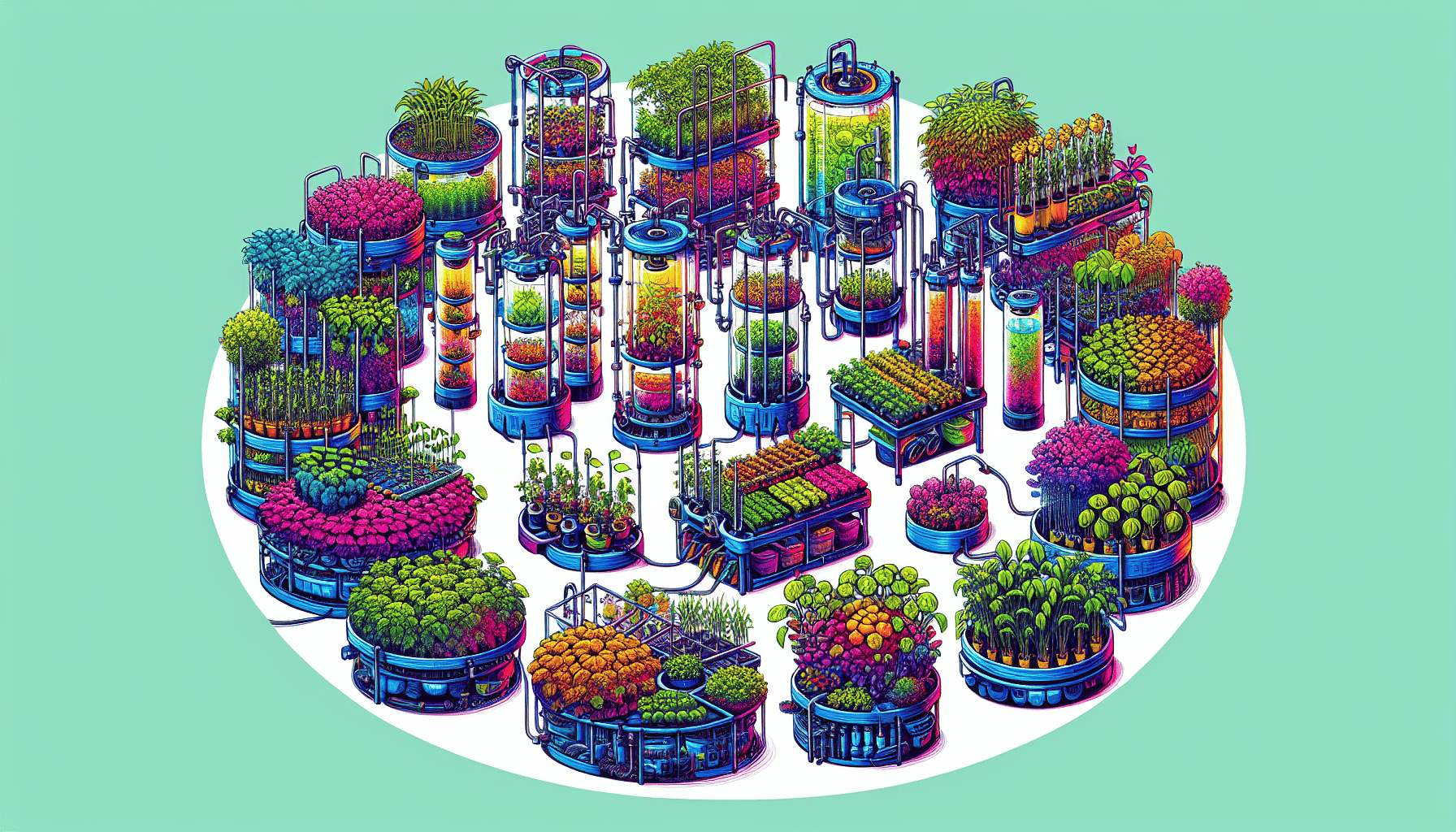
The possibilities for hydroponic systems are endless. Some examples include the nutrient film system, where plants are grown in channels with a constantly moving stream of water. The Nutrient Film Technique, which ensures a highly oxygenated nutrient solution. Deep water culture, where plants float in a nourishing water solution. And aeroponics, where they hang suspended in air and receive periodic mists of nutrients.
It is important to note that more complex systems may involve mechanical components, but it’s crucial to ensure proper functioning as any malfunction can quickly dry out your plants. To support the growth of hydroponic crops, drilling holes into container lids or using extruded polystyrene boards can be helpful. Additionally, substrates such as perlite,hydroton,pumice gravel, coconut coir, and rockwool provide root support and aid absorption of nutrients.Also,factors like adjustable wire shelves containers play an essential role towards maximizing space efficiency.However, it is necessary to regularly monitor pH levels,electrical conductivity,and concentration of dissolved nutrients for maintaining a healthy hydroponic environment.
When selecting containers for your hydroponically grown plant, consider its potential size so that there will be enough resources available for its mature canopy.It’s vital to keep track of all these factors in order to maintain an optimal growing environment and healthy plants overall.
The Simplicity of Wick Systems
The wick system is a cost-effective and straightforward method of hydroponic gardening. It utilizes the capillary action of water to transfer nutrients from a reservoir to plants, using materials like string, LECA draws, rope or fabric as conduits for the nutrient solution. This type of system works best with small and low-maintenance plants, ideal for beginners or those seeking minimal hassle.
To set up this kind of hydroponic system, you will need essential equipment such as a grow tray, reservoir, wicks and an air pump for proper ventilation. As far as methods go in the world of hydroponics, this one requires no advanced technology but still provides solid results.
Ebb and Flow System Explained
Subsequently, there’s the ebb and flow system, a commonly adopted hydroponic method. It is popular due to its efficiency and simplicity. In this system, plants grow in a tray with a substrate, while the water and nutrient solution are kept in a separate but connected reservoir. It operates by periodically flooding the plants with nutrient-rich water and then draining it back into the reservoir using gravity.
This system is particularly well-suited for larger plants, offering ample room for the plant’s roots to spread and absorb the nutrient-rich solution. It’s an excellent option for those looking to graduate from beginner-level systems to something a little more advanced.
Deep Water Culture (DWC): An Oxygen-Rich Environment
Let’s take a closer look at Deep Water Culture (DWC) in hydroponics. In this type of system, the roots of plants are suspended in oxygenated water that is rich in nutrients. Adequate levels of oxygen are crucial for plant health and protection from damage, making an airstone the most commonly used aeration device.
In recirculating DWC systems, containers are connected by tubing while a large pump moves oxygenated water between them and a reservoir. The key component of this setup is the air pump, which ensures proper oxygenation of the nutrient solution, promoting better absorption by roots and faster growth for plants. This method goes beyond traditional ebb and flow systems and is suitable for those looking to advance their hydroponic techniques.
Hydroponic Houseplants: Ideal Choices for Soilless Cultivation
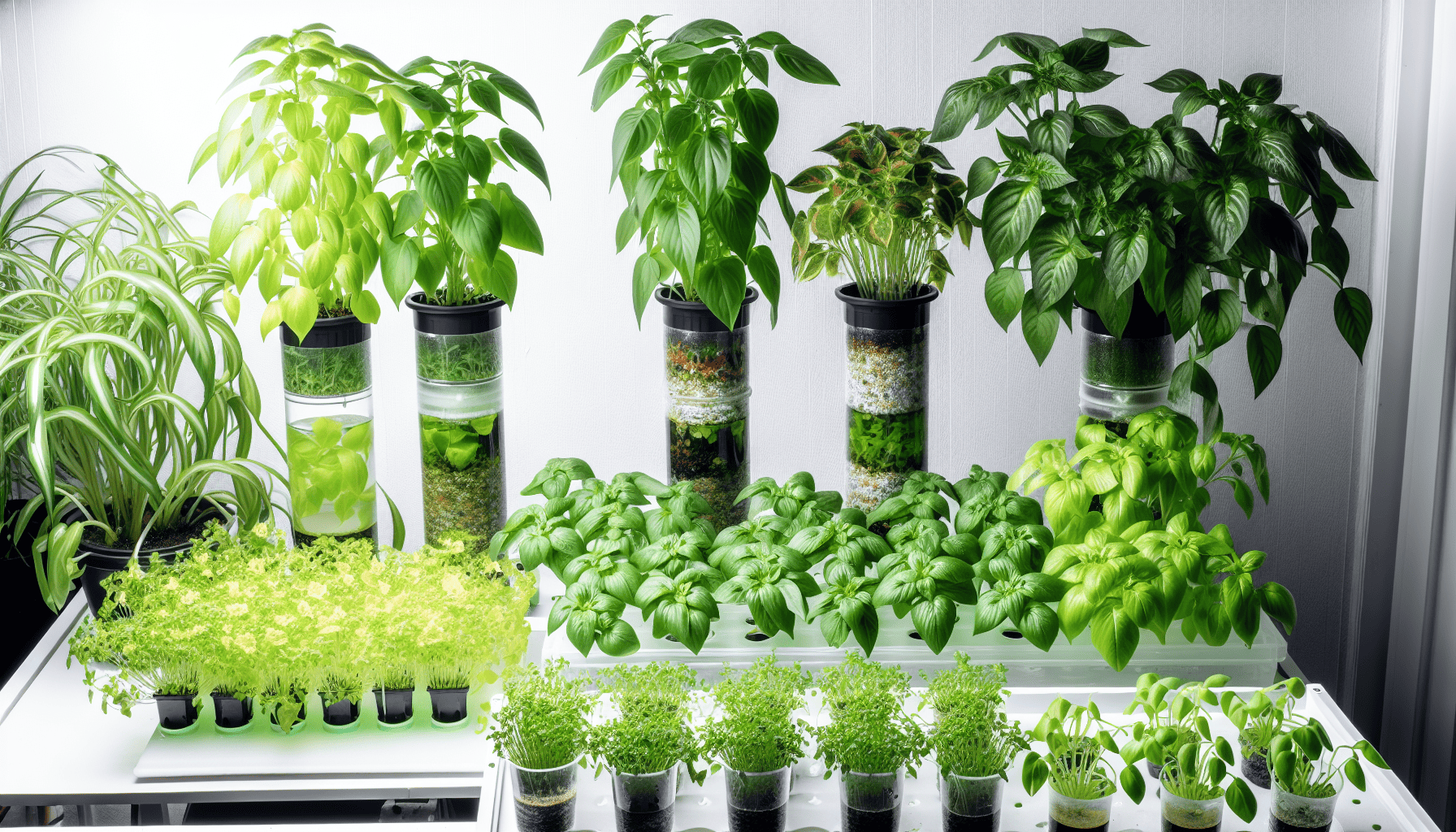
Once your hydroponic system is in place, the next step is to select suitable plants. Leafy greens and other small varieties are ideal for beginners due to their compatibility and ease of cultivation within a hydroponic system. There are also several decorative plants that thrive under these conditions, such as Monstera plant or Pothos.
These houseplants not only adapt well to hydroponics, but also add aesthetic value to indoor spaces. When growing ornamental species like Peace Lily or Arrowhead plants through this method, it’s essential to take into account water quality levels, structural support needs and specific light requirements, for instance Monstera prefers bright indirect sunlight while extra nutrients may be required by Peace Lily.
Whether you prefer vibrant green foliage or tropical blooms in your home garden setup using hydroponic systems allows one plenty of options from leafy greens like Coleus that can enhance visual appeal indoors too successfully nurturing exotic specimens including Spider Plant – so finding the perfect match shouldn’t prove difficult!
Nourishing Your Hydroponic Indoor Plants
To promote the thriving growth of your indoor plants in hydroponic systems, it is crucial to provide them with essential nutrients. These include macronutrients such as carbon, hydrogen, oxygen, nitrogen, phosphorus, potassium, and micronutrients like iron and zinc. Balancing these nutrients based on the specific needs of your hydroponic crops is key.
Maintaining a suitable pH level in water plays a vital role in how plants absorb necessary nutrients in hydroponics. When selecting fertilizers for this system type, it’s important to carefully examine their nutrient quantities and balance listed on labels ensuring they meet plant requirements.
By providing proper nourishment through optimal levels of both macro- and micro-nutrients while controlling pH levels effectively, you can guarantee robust growth and development for all types of indoor plants grown using hydroponics methods.
Harnessing the Advantages of Hydroponic Indoor Plants
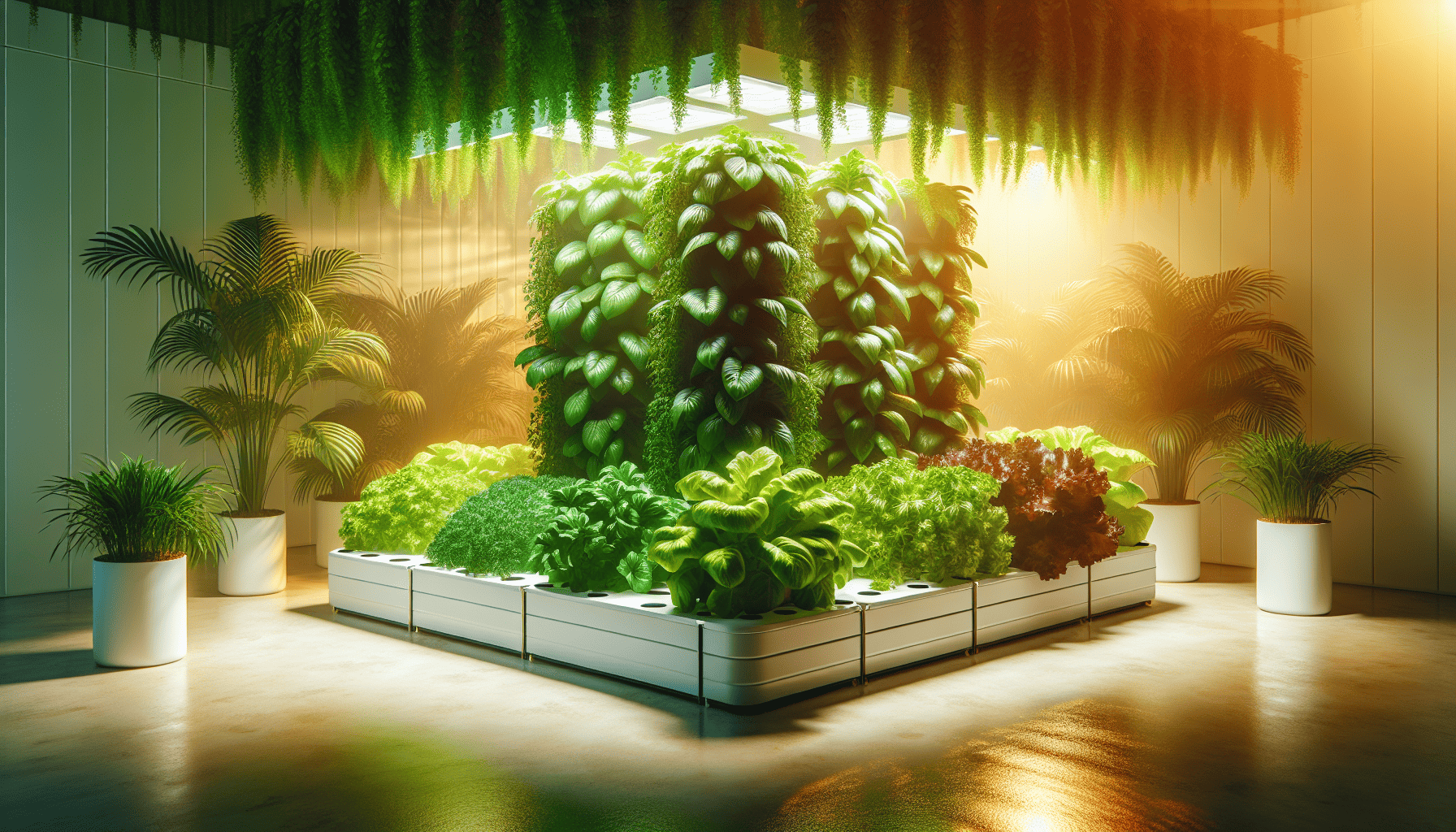
Hydroponics has numerous advantages, including low maintenance requirements and reduced need for pesticides due to fewer pest issues. Plants grown in hydroponic systems also experience faster growth, with a 30-50% increase in speed. This leads to quicker and more plentiful harvests.
Compared to traditional soil gardening, hydroponic gardening offers several benefits such as space efficiency and water conservation. The absence of weeds allows plants to receive undivided attention for their growth process. With proper care, hydroponically-grown plants can thrive for extended periods of time providing a continuous supply of fresh produce or vibrant greenery.
In summary, incorporating hydroponic systems into your living space brings efficiency and cleanliness while offering the joy of gardening directly at home.
Efficiency in Plant Nutrition
One major advantage of hydroponics is its ability to provide plants with necessary nutrition efficiently. In a hydroponic system, the plant’s roots are constantly submerged in a nutrient solution, allowing for continuous access to water, oxygen and nutrients. This efficient uptake process reduces the need for additional fertilizers.
Apart from essential macronutrients like nitrogen, phosphorus and potassium, microorganisms such as iron, copper,manganese, zinc,boron, and molybdenum must also be present in hydroponic systems as they can directly absorb these micronutrients from the nutrient solution unlike soil gardening where microbes break down fertilizer before being taken up by plants.This direct method of nutrient absorption contributes significantly towards effective plant nutrition compared to traditional soil cultivation methods.
Compared to traditional farming techniques that rely on microbial breakdown of fertilizers within soils prior consumption by crops, hydroponic setups offer an unparalleled direct way through which important minerals can effectively reach their target crop root zones.The efficacy involved in this approach serves at minimizing external fertilizer inputs because little or no losses occur during active transportation into seedling interiors & flower blossoming pods.
Swift Growth, Bountiful Harvests
Hydroponic gardening offers the benefit of rapid plant growth, which is made possible by increased oxygen levels in the nutrient solution and precise control over environmental factors such as light, air, and water. This allows for more efficient absorption of nutrients by plants. Compared to soil-grown plants, those grown hydroponically can grow 30-50% faster resulting in faster and larger harvests.
All types of plants, including leafy greens, herbs, tomatoes, and peppers, experience this accelerated growth when cultivated through hydroponics.With its ability to provide a satisfying gardening experience along with an effective means of growing both aesthetically pleasing or edible produce, hydroponics proves to be advantageous.
Whether you are interested in cultivating vegetation for visual appeal or fresh homegrown food supply, the use of hydroponic gardening techniques will not disappoint.Even though soil was traditionally used for planting, growing plants in water-nutrient solutions on controlled environments has proven benefits that help achieve impressive results across various species.
A Clean and Controlled Growing Space
Hydroponic systems offer a sanitary and regulated setting for the growth of plants. By eliminating soil and pests, these energy-efficient systems provide an ideal space for plant development. It is important to maintain this clean environment through regular removal of deceased plants, frequent cleaning of the grow room, occasional drainage of excess nutrient solution, and sterilization of the reservoir using substances such as hydrogen peroxide or vinegar. Furthermore, the use of hydroponics can help prevent pest infestations by implementing exclusion techniques,sanitizing practices, and consistent monitoring.
The sterile atmosphere created by hydroponic setups not only promotes robust plant growth, but also simplifies maintenance tasks in your garden.
Selecting the Right Plants for Your Hydroponic Garden
Now that you have familiarized yourself with the basics of hydroponics and its numerous advantages, it is important to discuss how to choose the right plants for your hydroponic garden. While there are many options when it comes to crops suitable for hydroponic cultivation – such as short-season vegetables like lettuce and spinach, herbs, and even fruiting plants like tomatoes, cucumbers, and peppers – leafy greens, herbs, and fruiting vegetables tend to thrive best in this environment. If you opt for an Ebb and Flow Hydroponic System specifically, you can consider growing lettuce, spinach, tomatoes (both beefsteak & cherry varieties),herbs or strawberries. It’s essential to remember that making wise choices in terms of plant selection can greatly enhance your overall experience with hydroponiculture.
The Art of Hydroponic Growing: Techniques and Tips
To become skilled in hydroponic growing, one must gain knowledge through experience and avoid common mistakes. It is important to be mindful of these pitfalls.
Neglecting pH levels
Not providing adequate lighting
Failing to comprehend hydroponic nutrients
Insufficient oxygenation for plants
-Poor circulation in the system
-Lack of regular maintenance.
In order to achieve desired nutrient balance, precise control over both nutrient levels and pH balance must be maintained within the reservoir. Utilizing fertilizer programs, formulas, and complete fertilizers can aid in achieving this equilibrium.
When propagating plants successfully, the following steps should be followed:
Take a cutting that includes at least one leaf node.
2.Place it into water until roots develop.
3.Provide ample distilled water,nutrients,and warm,bright light for optimal growth.
Lastly,to prevent plant diseases, it is recommended to regularly test the water, pay attention to using sulfur-based fungicides as well as implementing poly-plastic sheeting which helps repel pests from damaging crops.
Enhancing Your Home with Hydroponic Tropical Plants
The use of hydroponic methods for cultivating tropical plants at home offers a range of benefits, including eliminating the need for soil and reducing mess. These plant growth systems also make it possible to have indoor gardens with efficient space utilization, steady crop supply, and attractive aesthetics. These plants tend to grow faster and larger compared to those grown in traditional soil.
Some popular options among tropical hydroponic plants suitable for household cultivation include peace lilies, lettuce varieties like spinach or strawberries as well as bell peppers, and herbs such as basil or jalapeos.
To ensure optimal plant development within recommended parameters (65°F-70°F), maintaining appropriate temperature levels is crucial.
Incorporating these colorful hydroponically-grown tropical plants into your interior decoration can add an exotic touch while improving air quality indoors. With their ability to thrive without conventional gardening techniques involving planting directly on land or using pots filled with dirt, you won’t have messy spills from watering anymore by installing a structure ideal for growing anything ranging from small-scale herb gardens up through fruits plus vegetables.Growing them would be simpler since they do not require excessive maintenance routines either.These are some reasons why introducing more vibrant diverse species available where you live mightenlivenyour surroundingspace fashionably freshening ambiance conducive relaxing luxurious percepts refreshingplus inviting impression,,create mini-palm tree island paradise-like backyard sensation,wonderland literally flourishing full-fledged garden Eden stylish splendor enchanting flowery scenery will let any clod feel sure he’s living life oh-so smoothly comfortably perfectly flawlessly except ifyou’re headed outside thenyes entering back again after spending time chilling out sun-drenched burningly hot summertime shopping marathon running errands all over town
Cultivating Herbs and Leafy Greens Hydroponically
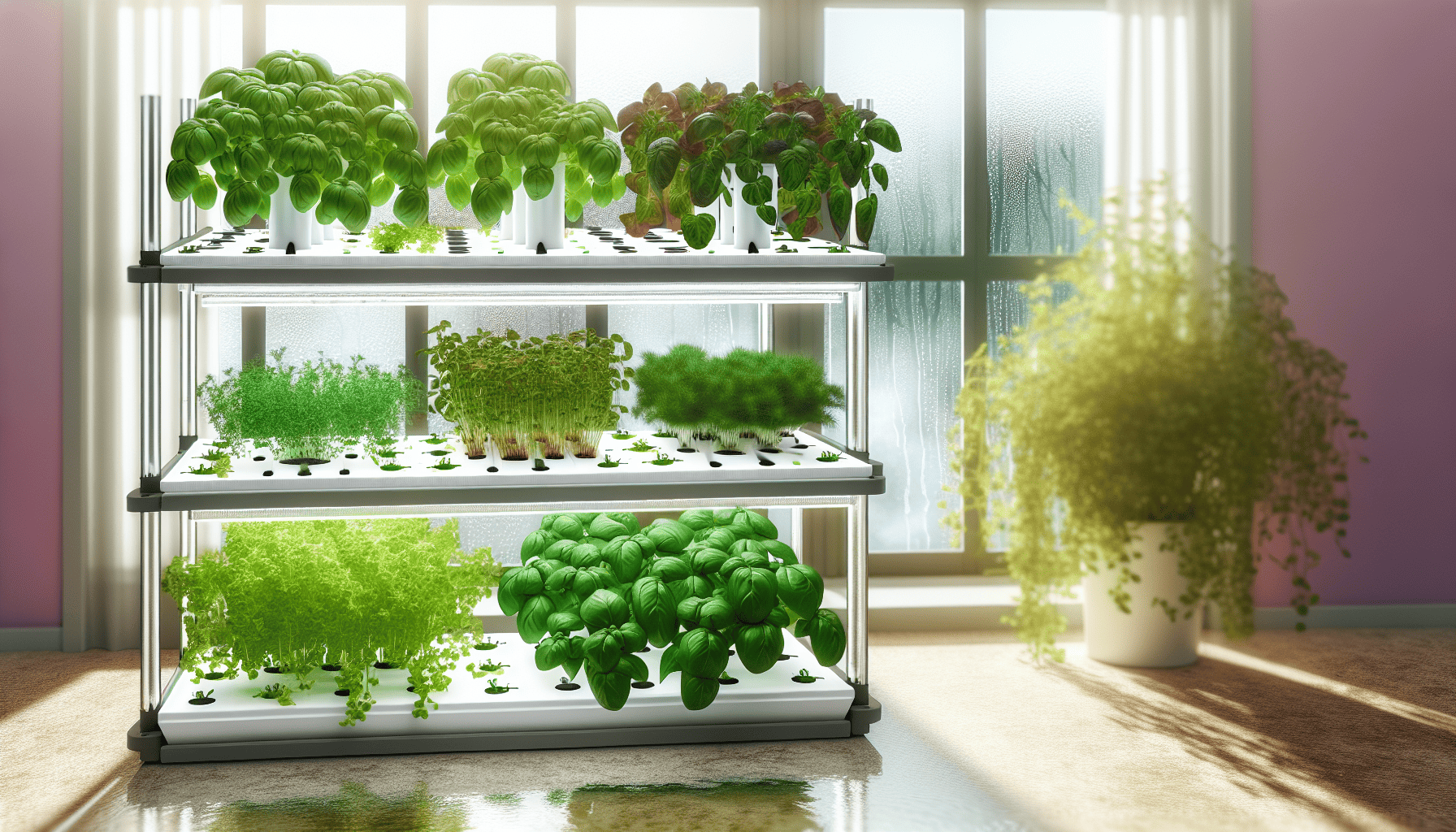
Imagine having access to fresh leafy greens and herbs all year round through the use of hydroponics. The practice of growing plants without soil is a great way to cultivate popular herbs such as basil, lavender, rosemary, and sage.
To successfully grow herbs using this method, it’s important to maintain specific conditions in your garden, including daytime temperatures between 65-70 degrees Fahrenheit and humidity levels ranging from 40-70%. Most commonly used culinary herbs like oregano, thyme, and cilantro thrive under these conditions alongside lettuce varieties.
One major benefit of hydroponic cultivation for both herbs and leafy greens is their ability for multiple harvests. It’s common for plants like basil,sage,parsley,chives,tarragon, and even some lettuces to be harvested up to five times before needing replanting with new seeds or starts.
The Joy of Hydroponic Tomatoes and Other Fruiting Plants
Growing tomatoes and other fruiting plants using hydroponic systems is a tempting prospect. With the use of ebb and flow or drip systems, one can easily achieve the dream of enjoying fresh, juicy indoor-grown tomatoes all year round. For optimal growth, it is crucial to maintain an EC level between 2.0 and 3.5, pH levels ranging from 5.8 to 6.3 and daytime temperatures around (18 -25 °C) 65-77 degrees Fahrenheit.
It takes approximately two months for hydroponic tomato plants to reach maturity and start producing fruits, which typically happens in about eight to twelve weeks’ time frame.Pollination of these fruiting plants can be achieved by transferring pollen with a paintbrush from male flowers onto the center of female ones.To indulge in bountiful harvests throughout every season, the delight that comes with cultivatinghydroponictomatoes and other fruit bearing plants cannot be beat.This practice allows for an uninterrupted supply offresh produce, a truly unmatched experience!
Maintaining a Healthy Hydroponic Environment
Ensuring the optimal conditions for growth in a hydroponic system is crucial for healthy plant development. It is recommended to change the water every 2-3 weeks and completely replace the reservoir’s water every 7-10 days in order to maintain a healthy environment.
Keeping an eye out for common pathogens, such as powdery mildew, downy mildew, and root rots, that can affect plants’ health is also important. As part of pest management techniques, one method involves gently wiping infested leaves with diluted dish soap and water using a cotton ball or q-tip. These practices are essential for promoting thriving plants within your hydroponic setup.
Summary
In the world of hydroponic gardening, the possibilities are almost endless. From the basic principles of hydroponics, the variety of systems, to the ideal plants for your soilless garden, the journey is both exciting and rewarding. Embrace the advantages of hydroponics — efficient plant nutrition, swift growth, clean and controlled growing environment, and the joy of cultivating your own fresh produce or decorative plants. With the right knowledge, tools, and a bit of love for greenery, you can transform your home into a lush, thriving hydroponic garden.
Frequently Asked Questions
What plants can be grown hydroponically?
Hydroponic growth allows for a diverse range of plants to flourish, such as leaf lettuce, tomatoes, peppers, cucumbers, strawberries, watercress celery and selected herbs. In order to effectively support each crop within the nutrient solution, it is crucial to carefully plan out your system design.
It is important to consider how each plant will be sustained by the necessary nutrients in their specific hydroponic environment. This applies specifically when designing systems for crops like leafy greens or other smaller plants compared with larger plants.
Are hydroponic plants worth it?
Setting up a hydroponic garden is highly beneficial as it offers cost-effective, efficient and eco-friendly solutions to water scarcity. It allows individuals to have their own indoor hydroponic gardens that offer various advantages.
The decision to start an indoor hydroponic garden should not be overlooked due to its numerous benefits such as being budget-friendly, time-saving and environmentally conscious. This innovative method of growing plants is ideal for areas experiencing water shortages.
Can all houseplants be grown hydroponically?
Growing plants hydroponically is possible for most plant species, although some may require specific adaptations in order to flourish within this system.
How often do you water hydroponic plants?
Water hydroponic plants thoroughly, ensuring the growing media becomes completely wet. Avoid watering for short periods multiple times a day, and instead opt for a few minutes of watering to maintain optimal growth.
Is hydroponic gardening suitable for beginners?
Hydroponic gardening is an ideal option for those new to the practice as it offers flexibility in terms of complexity, making it accessible for individuals with varying levels of experience. It can be kept simple or made more intricate, catering to a wide range of skill levels while still retaining all essential information.


